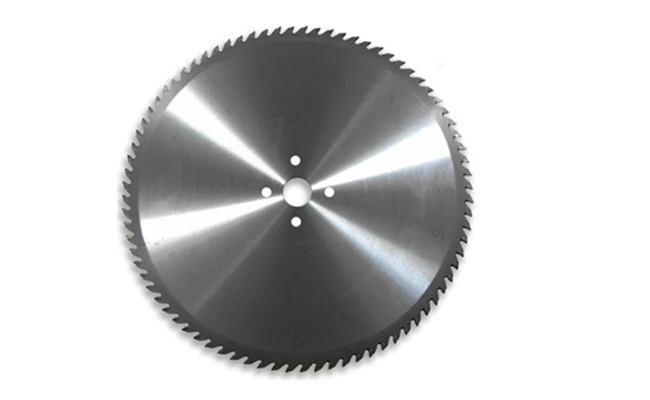BS-260G Horizontal Band Saw
Cutting Capacity :
The choice between these two blades comes down to a trade-off between cost, durability, and application.
Here’s a detailed breakdown of a bi-metal blade versus a carbide-tipped blade.

The Core Concept: A blade made of two different types of steel welded together to get the best properties of each.
The Body (Backing): Made of a flexible, high-carbon spring steel. This makes the blade very durable and resistant to shattering under stress and bending.
The Teeth: Made of a separate, much harder High-Speed Steel (HSS) that is electron-beam welded onto the body. HSS can withstand the high friction heat generated when cutting metal.
Think of it as: A flexible, shock-absorbing body with incredibly hard, heat-resistant teeth.
Best For: Cutting METAL and other hard materials.
Steel, aluminum, copper, brass
Stainless steel (with the appropriate tooth design and lubrication)
Plastics, fiberglass
Often used on reciprocating saws (Sawzalls), band saws, and portable circular saws for demolition and metalwork.
Key Characteristics:
Pros:
Flexible & Durable: The spring steel body can withstand twists, bends, and impacts that would snap a rigid blade.
Heat Resistant: The HSS teeth stay hard even when they get red-hot.
Cost-Effective for Metal: They are the standard for metal cutting and last much longer than carbon steel blades.
Cons:
Dulls Faster on Wood: While it can cut wood, it will dull much more quickly than a carbide blade when used on lumber, especially with nails or dirt.
Not for Fine Woodworking: The teeth are integrated and can’t be sharpened to the same razor edge as carbide, so cuts in wood won’t be as clean.

The Core Concept: A blade with individual teeth (tips) made of ultra-hard carbide that are brazed (a high-temperature welding process) onto a steel body.
The Body: Made of a rigid, high-quality steel. It’s not designed to be flexible like a bi-metal blade.
The Teeth (Tips): Made of Tungsten Carbide, a material that is significantly harder than HSS. It’s so hard and brittle that the tips are often just small rectangles brazed onto the steel tooth.
Think of it as: A rigid, precision body with individual, super-hard “chisels” (the carbide tips) that stay sharp for a very long time.
Best For: Cutting WOOD and wood-composite materials.
Dimensional lumber, plywood, MDF, OSB
Hardwoods and softwoods
Melamine and laminated materials
The standard blade for table saws, miter saws, and circular saws used in woodworking and carpentry.
Key Characteristics:
Pros:
Extreme Hardness & Edge Retention: Stays sharp up to 50-200 times longer than a steel blade when cutting wood. It resists abrasion from the resins in plywood and MDF.
Clean, Precise Cuts: Ideal for fine woodworking and finish carpentry where a smooth cut is critical.
Can Be Re-sharpened: A skilled professional can re-sharpen the carbide tips multiple times, extending the blade’s life significantly.
Cons:
Brittle: Carbide tips are prone to chipping if they hit a nail, rock, or are dropped on a hard surface.
More Expensive: The initial cost is much higher than a bi-metal blade.
Rigid: The blade body is not flexible and can crack under impact or misuse.
| Feature | Bi-Metal Blade | Carbide-Tipped Blade |
|---|---|---|
| Primary Use | Cutting Metal | Cutting Wood |
| Tooth Material | High-Speed Steel (HSS) | Tungsten Carbide |
| Blade Body | Flexible Spring Steel | Rigid Steel |
| Durability | High (Resists bending & shock) | High (Resists abrasion) |
| Hardness | Hard | Extremely Hard |
| Edge Retention | Good on metal | Excellent on wood |
| Brittleness | Low (Teeth are tough) | High (Tips can chip) |
| Cost | Moderate | Higher |
| Best On | Reciprocating Saws, Band Saws | Table Saws, Miter Saws |
“Can I use a carbide-tipped blade to cut metal?”
Generally, No. The extreme hardness and brittleness of carbide mean that hitting the rigid structure of metal can easily chip or shatter the tips. It’s also the wrong tooth geometry.
“Can I use a bi-metal blade to cut wood?”
Yes, but it’s not ideal. It will work in a pinch, especially for rough cuts where a nail might be present. However, it will dull much faster than a carbide blade and won’t leave a clean finish.
It’s worth mentioning a third type: the Carbide Grit Blade. Instead of sharp teeth, the edge is a continuous rim coated with industrial diamond or silicon carbide grit. These are used for extremely abrasive materials that would quickly destroy a toothed blade, such as:
Fiber cement board (like HardieBacker)
Ceramic tile
Slate and brick
Choose a Bi-Metal Blade when your primary task is cutting metal and you need a blade that can handle shock and flex.
Choose a Carbide-Tipped Blade when your primary task is cutting wood and you want a long-lasting, clean-cutting blade.
Cutting Capacity :
Cutting Capacity :